HVAC Resume: Examples, Templates & Writing Tips
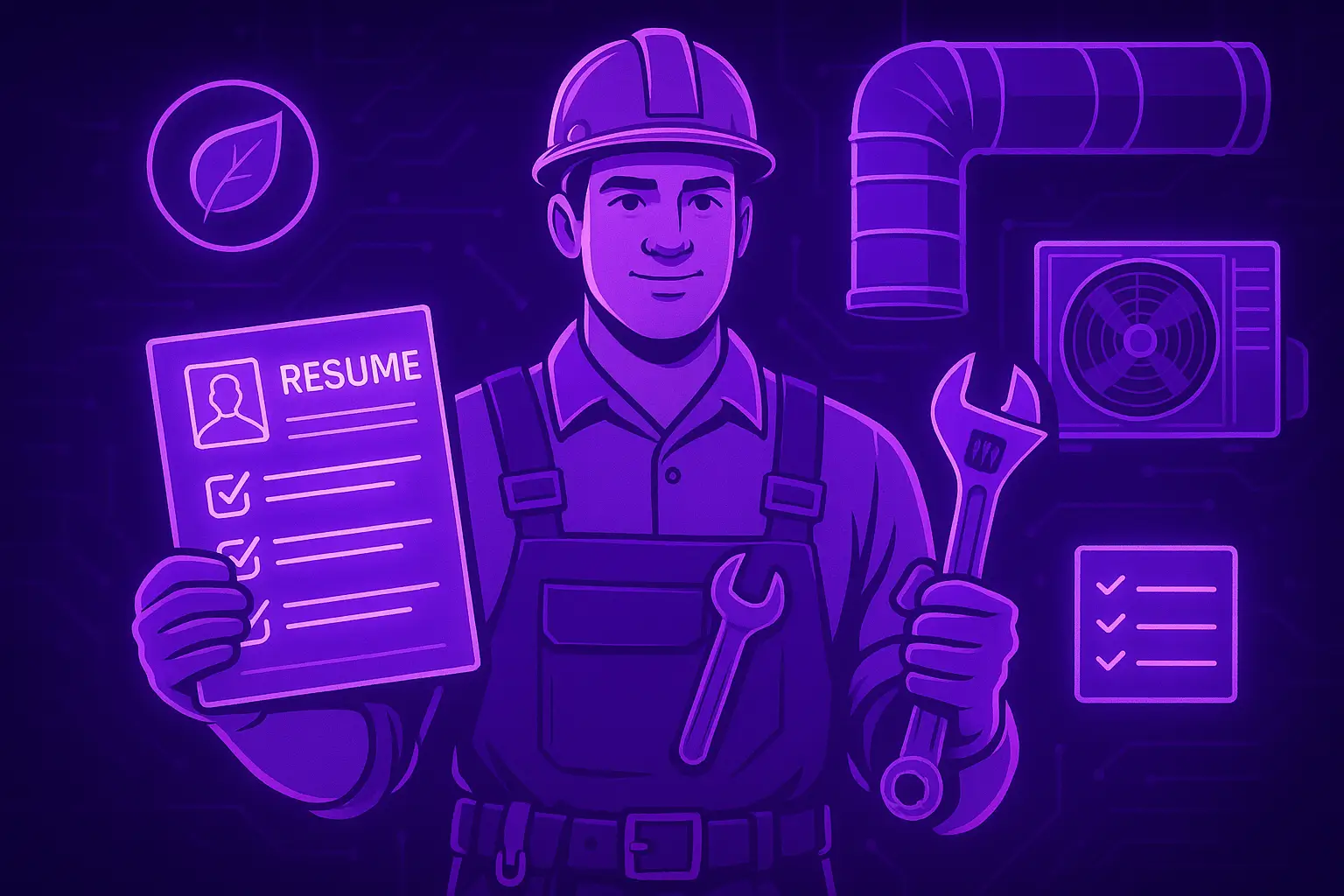
A top-notch HVAC resume is your golden ticket. It's the single most powerful tool you have for landing a better job, commanding a higher salary, and building the career you really want. Forget thinking of it as just a list of past jobs; it's a strategic sales pitch that proves your value to a potential employer by highlighting your unique skills, measurable achievements, and critical certifications.
Why Your HVAC Resume Is Your Most Important Tool
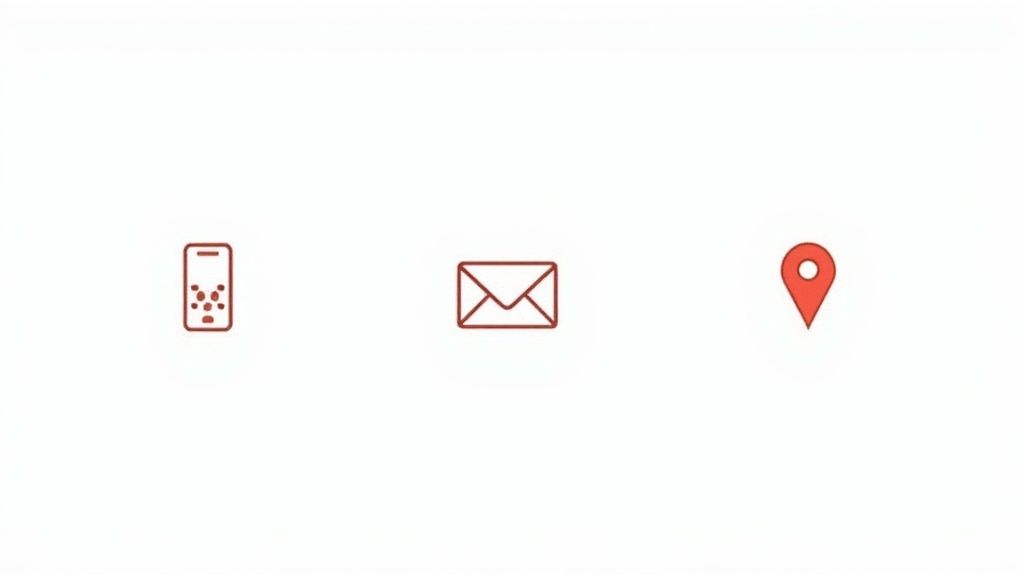
Let's be real—in this booming industry, a generic, cookie-cutter resume is a one-way ticket to the "no" pile. The game has changed. Employers aren’t just looking for someone who can turn a wrench anymore. They need sharp technicians who can diagnose complex issues, talk to customers with confidence, and directly contribute to the company's success.
The competition is heating up, largely because the industry is expanding so quickly. The U.S. Bureau of Labor Statistics (BLS) is projecting a 10% growth in HVAC employment between 2024 and 2034, which is way faster than the average job. That translates to roughly 42,500 new job openings every single year. In a market this hot, you absolutely have to stand out.
Ditch the Job Description—Show Your Impact
I see this mistake all the time. Technicians just list their responsibilities like they're copying a job description. A hiring manager already knows the basics of what an HVAC tech does. What they don't know is how well you do it. Your resume needs to stop describing duties and start showcasing accomplishments.
For example, don't just say this:
- Performed routine maintenance on residential units.
Instead, frame it to show your value, like this:
- Executed a preventive maintenance program for over 50 residential clients, slashing seasonal emergency calls by 15%.
See the difference? That small shift takes you from a guy who just shows up to a proactive problem-solver who delivers real, tangible results. That’s the kind of value that grabs a hiring manager's attention and lands you the interview.
Your Resume is a Career Investment
Treat your resume like a direct investment in your future. A sharp, well-written document doesn't just get you in the door; it opens up opportunities for better pay, more responsibility, and positions with the best companies in the business. It’s your first—and often only—chance to make a killer impression.
A strategically built resume does more than get you an interview; it sets the stage for salary negotiations by immediately establishing your worth. It tells a story of competence, reliability, and impact.
This means every single word on your resume counts, from the headline down to the skills section. Everything must be deliberate. Even the title of your resume is critical for making a strong first impression. For some great ideas on crafting a header that pops, check out these resume title examples. A powerful title and a compelling summary are the one-two punch that will make a hiring manager stop scrolling and start reading your story.
Build an Experience Section That Shows Real Impact
Let's get straight to it: your experience section is where you either win the interview or get tossed in the "no" pile. This is the most valuable real estate on your entire HVAC resume, yet it's where most technicians completely miss the mark. They just list their job duties.
Here's a hard truth: the hiring manager already knows what an HVAC tech does. They don't need a laundry list of responsibilities. What they desperately want to know is what you accomplished.
Stop thinking about what you were told to do and start focusing on the results you delivered. Making this one mental shift is the most powerful change you can make to your resume. It’s what separates a resume that gets a passing glance from one that gets you a call.
From Vague Duties to Powerful Achievements
So, how do you make this change? Let's take a common, boring duty and turn it into something that grabs attention. Almost every HVAC resume includes something like, "Performed routine maintenance." Yawn.
To make this compelling, you need to ask yourself a simple question: so what? What was the real outcome of that maintenance?
Action Verb + Specific Task + Quantifiable Result
Using this framework, that bland duty transforms. Instead of "Performed routine maintenance," you get: "Reduced emergency callbacks by 25% across a 40-unit commercial portfolio by implementing a proactive quarterly maintenance schedule."
See the difference? Now you're not just a wrench-turner; you're a strategic thinker who directly saves the company time, money, and headaches. That second version tells a story of tangible value. It proves you understand the business behind the b-vent—that minimizing costly reactive repairs is just as important as the repair itself.
If you need more inspiration for framing your wins, digging into some professional achievements examples can really help get the ideas flowing.
Transforming Duties into Achievements
To really drive this home, let’s look at how to rephrase some standard, everyday tasks into high-impact statements that hiring managers can't ignore.
This table shows a clear before-and-after. On the left, you have a passive list of tasks. On the right, you have an active demonstration of your value, packed with the kind of results that get you hired.
Uncovering Your Quantifiable Wins
Right now, you might be thinking, "That's great, but I don't track numbers like that." I hear this all the time, but you probably have more data at your fingertips than you realize. You just have to know where to look.
Think about the real-world impact of your work:
- Efficiency: Did you figure out a smarter way to stage your materials, completing installations faster than the quoted time? By what percentage?
- Customer Retention: Were you the go-to tech for difficult clients? Did you successfully turn a negative review into a 5-star rating?
- Cost Savings: Did your sharp diagnostic skills catch a small issue before it cascaded into a catastrophic (and expensive) system failure?
- Team Contribution: Did you create a checklist that helped the whole team reduce callbacks? Did you train a new guy and help him pass his certifications?
Even if you don't have the exact spreadsheet data, you can make a solid, good-faith estimate. A statement like "Improved first-time fix rates by an estimated 25% by introducing a new digital diagnostic tool to the team" is incredibly compelling.
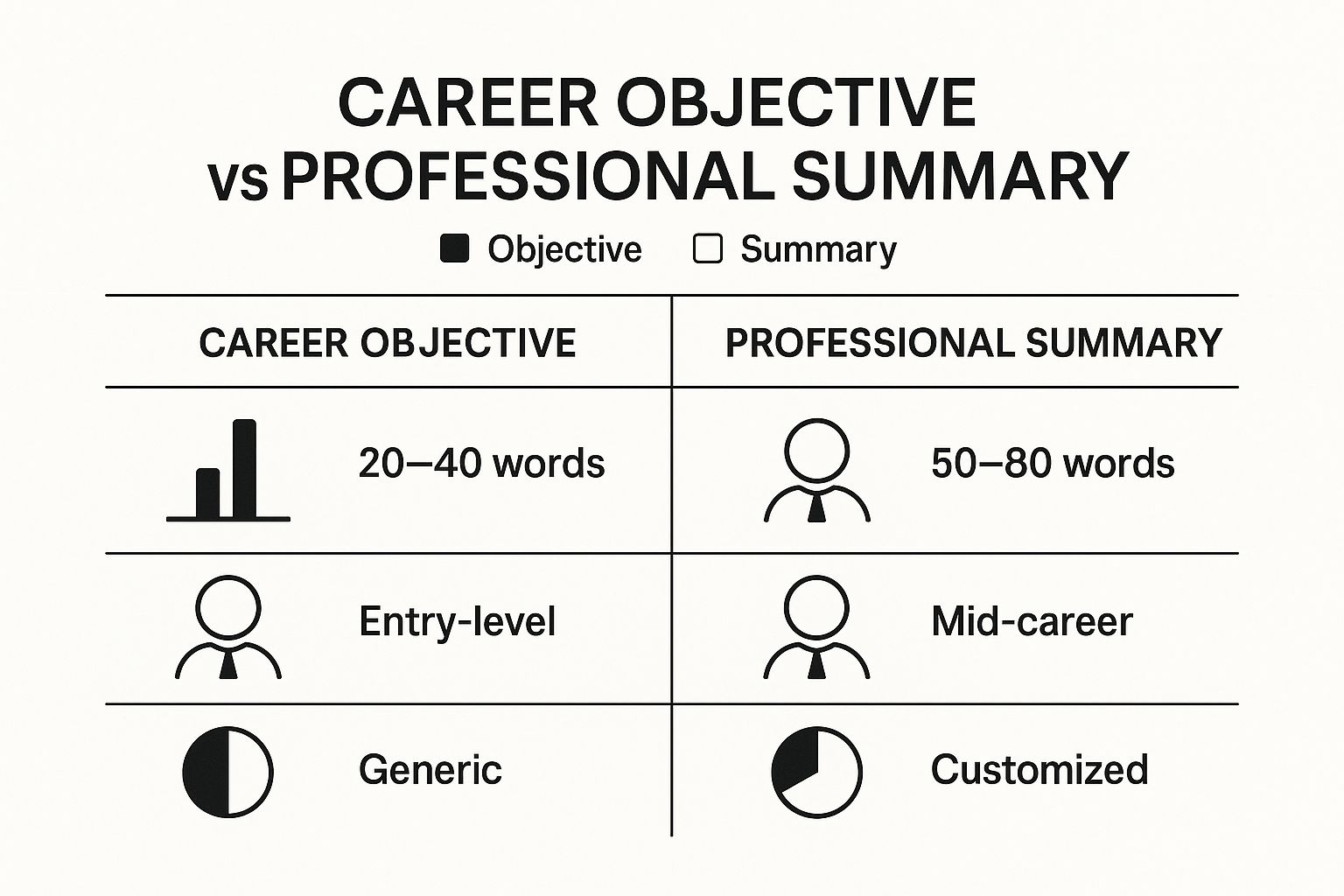
Your experience section is your sales pitch. It's your chance to prove you’re not just another candidate—you're an investment. Use strong, confident action verbs like Overhauled, Streamlined, Engineered, and Diagnosed. Back them up with hard numbers and concrete results to paint a vivid picture of the value you bring.
Do that, and your resume won't just be a history of your past jobs. It'll be a powerful argument for your future success.
Showcase Your Most Valuable Skills and Certifications
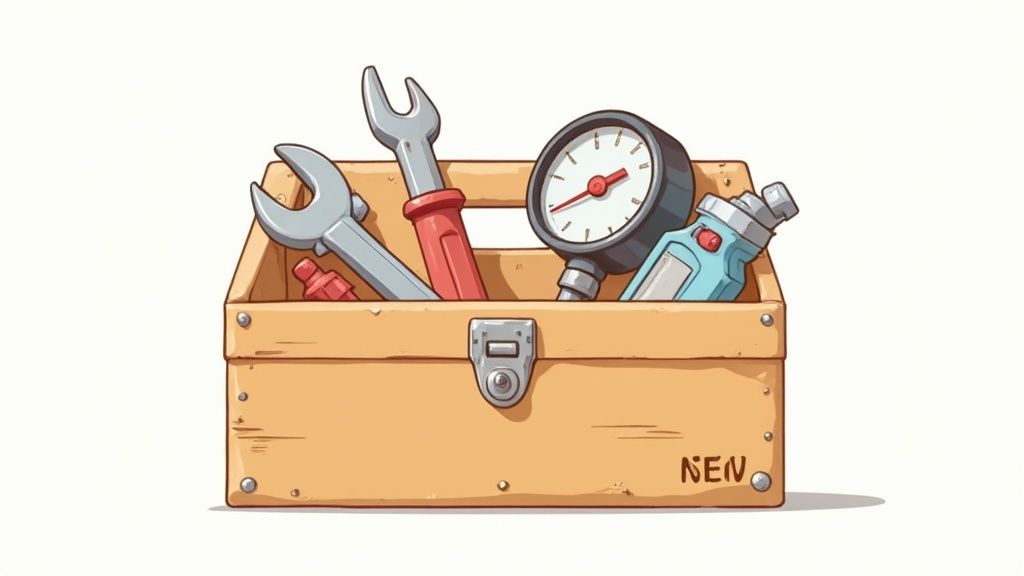
In the HVAC world, your skills and certifications are your currency. Let's be honest—this section is often the first place a hiring manager looks to see if you have the right stuff. It's a quick gut-check area that confirms you meet the absolute minimums for the job.
But it’s even more critical for getting past the initial gatekeepers: Applicant Tracking Systems (ATS). These bots are programmed to hunt for specific keywords like "EPA 608," "NATE," or "OSHA." If those terms aren't listed clearly, your resume could end up in the digital trash can before a person ever lays eyes on it.
To really nail this, you need to get inside the employer's head. You can get a better sense of their expectations by understanding the requirements for a consultant role, as many of the principles around demonstrating core competencies apply here, too.
Structure Your Skills for Maximum Impact
Whatever you do, don't just dump all your skills into one giant, unreadable paragraph. That's a huge red flag. Instead, break them down into logical categories. An organized layout shows professionalism and helps a busy manager find exactly what they’re looking for in seconds.
Try using clear subheadings like these:
- Technical Proficiencies: This is for your hands-on abilities. Think refrigerant handling, brazing and soldering, ductwork fabrication, and advanced system diagnostics.
- Certifications & Licenses: Put your heavy hitters right here. Lead with your EPA Universal 608, any NATE certifications, and state-specific licenses.
- Diagnostic Tools & Software: List the specific gear you know how to use. Mentioning things like Fieldpiece manometers, thermal imaging cameras, or software like ServiceTitan shows you're ready to hit the ground running.
- Safety Protocols: Briefly note your familiarity with critical safety standards like OSHA 10/30, lockout/tagout procedures, and proper PPE use.
This clean structure is one of the key components of a resume that makes your qualifications pop off the page.
Prioritize What Matters Most
Not all skills carry the same weight. Always lead with the abilities and certifications that are most in-demand or are explicitly called out in the job description. If the posting screams "commercial refrigeration," you better believe your experience with walk-in coolers and ice machines should be right at the top.
A well-organized skills section acts as a powerful checklist for hiring managers. It quickly validates your technical competence and tells them you possess the exact qualifications they need, making their decision to call you for an interview much easier.
The industry trend is clear: employers want certified professionals. With thousands of openings and median wages pushing toward $70,000 annually, companies are looking for techs who can prove their value from day one. Showing you have the credentials they’re looking for is no longer optional—it's essential.
Write a Professional Summary That Hooks the Reader
You’ve got about six seconds. That’s the reality. Before a hiring manager even thinks about diving into your work history, their eyes will land on your professional summary. This little block of text at the top of your resume is your make-or-break moment—it's your elevator pitch, and it needs to be sharp enough to stop them in their tracks.
A bland, generic summary is the fastest way to get your resume tossed aside. A powerful one, on the other hand, immediately tells the reader who you are, what you bring to the table, and why they absolutely need to keep reading. It’s your single best opportunity to hook them from the get-go.
A Simple Formula for a Powerful Summary
Let's get one thing straight: "Hard-working HVAC technician seeking a new opportunity" tells a hiring manager absolutely nothing useful. It's filler. Instead, I teach technicians to use a simple but incredibly effective formula that cuts through the noise.
Think of it this way: Years of Experience + Key Specialization + Top 2-3 Quantifiable Achievements.
This structure isn't just a template; it forces you to be specific and to think in terms of results. You’re not just telling them you’re good—you’re showing them how good. It’s a blueprint for proving your value before they even get to the second page.
For instance, here's what a seasoned commercial pro might write:
"NATE-certified commercial HVAC Technician with 10+ years of experience specializing in large-scale rooftop unit installation and VRF systems. Proven ability to reduce system downtime by 30% through proactive maintenance programs and improved first-time fix rates by 20% on complex diagnostic calls."
See the difference? It’s packed with value. And don't worry, this approach works just as well if you’re fresh out of trade school. Just lean into your training and what you excelled at:
"EPA Universal certified HVAC graduate with extensive hands-on training in residential system installation and diagnostics. Achieved a 98% final grade in advanced electrical troubleshooting coursework and led a team project that successfully installed a complete split system 15% under budget."
Customize Your Summary for Every Single Job
If you take only one piece of advice from this guide, let it be this: you must customize your summary for every job you apply for. This is the secret weapon that most applicants ignore.
Pull up the job description and read it like you're studying for a test. What keywords jump out? Are they desperate for someone with geothermal experience? Is their main goal to cut down on customer complaints? Whatever their pain point is, you need to reflect that language in your summary.
By mirroring the language from the job posting, you're not just tailoring your HVAC resume; you're telling the hiring manager, "I am the solution to your problem." This simple step dramatically increases your chances of getting an interview.
Taking a few extra minutes to do this shows you’ve done your homework and are serious about their company, not just any old job. And please, before you hit send, give it one last look. A single typo can completely derail the professional image you’ve worked so hard to build. Applying a few solid proofreading tips is a non-negotiable final step.
Design a Clean Resume That Is Easy to Read
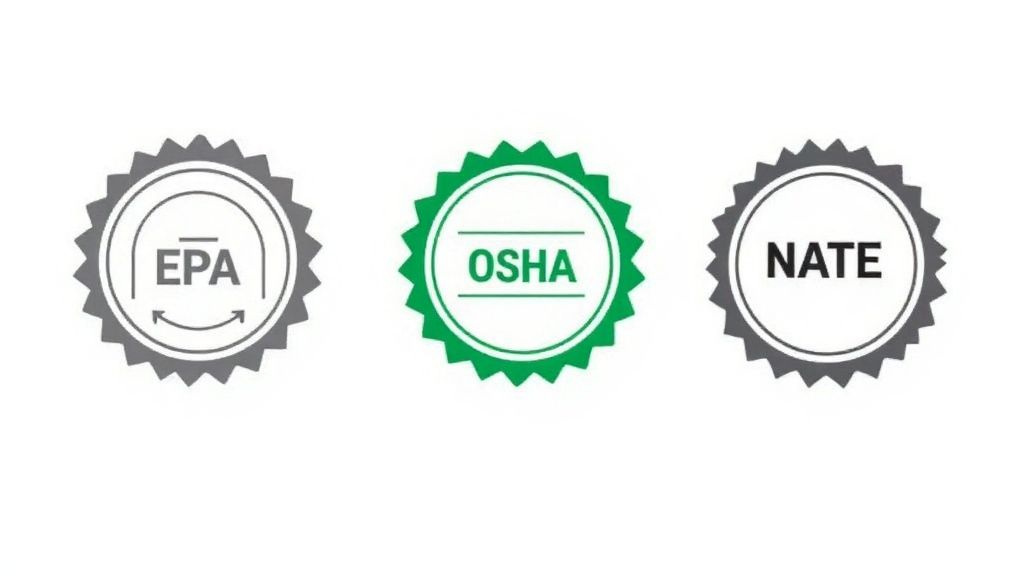 You could be the best technician in your state, with a track record of incredible achievements, but if your resume is a cluttered mess, it’s not getting a second look. It's a hard truth: great content gets completely lost in a bad layout.
You could be the best technician in your state, with a track record of incredible achievements, but if your resume is a cluttered mess, it’s not getting a second look. It's a hard truth: great content gets completely lost in a bad layout.
Think of your resume like a clean schematic. A hiring manager, who is often buried in applications, needs to quickly follow the flow and pinpoint the most critical information in just a few seconds. A professional, easy-to-read design tells them you’re meticulous and detail-oriented—two qualities every great employer is looking for. The simplest way to achieve this is with plenty of white space, which guides the eye and keeps your resume from looking like an intimidating wall of text.
Choose Professional and Readable Fonts
This isn't the time to get creative. Stick with classic, clean fonts that are easy to read on any screen. Your best bets are options like Calibri, Arial, Georgia, or Times New Roman in a 10-12 point size. Steer clear of script or overly decorative fonts; they just look unprofessional and can be a real headache to decipher.
To make your resume scannable, use bold, clear headings to separate the sections. This creates a logical hierarchy that helps a manager find your experience, skills, and certifications without having to hunt for them.
Master the Art of ATS Optimization
Here's something many technicians overlook: before a person ever sees your resume, it’s almost guaranteed to be scanned by an Applicant Tracking System (ATS). These are software bots that filter candidates based on formatting and keywords. If your resume isn’t built to pass this initial screening, it might get tossed into a digital rejection pile automatically.
To make sure you get past the bots, here are a few simple rules:
- Use Standard Headings: Don't get fancy with section titles. Stick to simple, universally recognized headers like “Work Experience,” “Skills,” and “Education.”
- Avoid Complex Graphics: Tables, columns, images, and special characters can seriously confuse an ATS, causing it to scramble your information or miss it entirely.
- Lean on Bullet Points: Use simple round or square bullet points to break up your job descriptions. This makes your accomplishments easy to scan for both the software and the hiring manager who reads it next.
Your resume's format is just as important as its content. A clean, ATS-optimized layout is what ensures your hard-earned skills and achievements actually make it in front of a real person.
If you want to get this part perfect, checking out a guide on https://aiapply.co/blog/ats-friendly-resume-templates can give you a major leg up on the competition.
Finally, a crucial last step: always save and send your resume as a PDF. This locks in your formatting, so it looks exactly as you intended, no matter what device someone opens it on. Before you hit send, run it through a reliable grammar checker for a final polish. A clean, error-free document is the ultimate sign of a true professional.
Your Top HVAC Resume Questions, Answered
Even after following a guide, you're bound to have some specific questions pop up as you're polishing your resume. It’s completely normal to hit a couple of snags. Let's tackle some of the most common hurdles I see technicians face, so you can get your resume across the finish line with confidence.
Think of this as a quick-reference FAQ from someone who's seen what works. I'll give you straight, no-fluff answers to those tricky situations that can leave you second-guessing.
How Long Should My HVAC Resume Be?
For the vast majority of technicians, the answer is simple: one page. Sticking to a single page isn't just a guideline; it's a strategic choice. It forces you to be ruthless and showcase only your most impressive, relevant accomplishments.
Let's be real—hiring managers are swamped. A tight, powerful one-page resume respects their time and makes your value crystal clear in seconds. Now, if you have over 15 years of deep experience, especially in senior management, specialized industrial work, or as a project lead, a two-page resume can be justified.
But remember this: a strong one-page resume will always beat a weak two-page one. If you're struggling to trim it down, that's your cue to focus less on listing duties and more on quantifying your biggest wins.
How Do I Write an HVAC Resume With No Experience?
When you're new to the field, your resume has to sell your potential, not your past work history. The trick is to pivot the focus away from professional experience and toward your training and raw technical talent.
Right after your professional summary, make your "Education & Technical Training" section the star of the show. This is your new centerpiece. Instead of listing job duties, use your bullet points to show what you did in the classroom and the lab.
- Highlight specific hands-on projects. For example: "Led a team project to successfully install a complete residential split system 15% under budget."
- Showcase academic success in key areas, like: "Achieved a 98% final grade in advanced electrical troubleshooting coursework."
- Make sure your EPA 608 Certification and any other credentials are front and center.
Your professional summary should then echo this same theme, emphasizing your work ethic, technical aptitude, and genuine excitement to learn and become a valuable part of the team.
Should I Include Soft Skills on My Resume?
Absolutely, but you have to be smart about it. A lazy list of words like "Problem-Solving" or "Team Player" is completely meaningless to a hiring manager. Why? Because there's no proof. You have to show your skills in action, not just tell people you have them.
The best way to do this is to weave those soft skills directly into your achievement-focused bullet points. This gives concrete evidence of how you apply your abilities on the job.
Don't do this:
- Problem-Solving
Instead, do this:
- Diagnosed and resolved complex intermittent system failures 30% faster than the team average, significantly reducing frustrating repeat customer calls.
See the difference? The second example proves your problem-solving skill in a way that shows a direct benefit to the company—happier customers and better efficiency. You can dig into more of these strategies by exploring different resume optimization techniques.
How Do I Explain a Gap in My Employment History?
Handle employment gaps with honesty and simplicity. On the resume itself, you don't need a lengthy explanation. Just list your employment dates accurately. The gap will be there, and that's perfectly fine.
If you were productive during your time away from work, you can absolutely show that off. Consider adding a section like "Professional Development" or "Additional Projects" to highlight any new certifications you earned or skills you learned during that period.
The real key is being ready to talk about it confidently in an interview. Frame the time off positively—whether it was for personal growth, family needs, or skill-building—and then quickly pivot the conversation back to how you're now fired up and ready to bring your skills to their company.
Ready to stop stressing over formatting and start landing interviews? The AIApply platform helps you build a perfectly structured and optimized HVAC resume in just a few minutes. Let our AI-powered tools spotlight your biggest achievements and create a professional document that gets you noticed. Start building your future at https://aiapply.co.
A top-notch HVAC resume is your golden ticket. It's the single most powerful tool you have for landing a better job, commanding a higher salary, and building the career you really want. Forget thinking of it as just a list of past jobs; it's a strategic sales pitch that proves your value to a potential employer by highlighting your unique skills, measurable achievements, and critical certifications.
Why Your HVAC Resume Is Your Most Important Tool

Let's be real—in this booming industry, a generic, cookie-cutter resume is a one-way ticket to the "no" pile. The game has changed. Employers aren’t just looking for someone who can turn a wrench anymore. They need sharp technicians who can diagnose complex issues, talk to customers with confidence, and directly contribute to the company's success.
The competition is heating up, largely because the industry is expanding so quickly. The U.S. Bureau of Labor Statistics (BLS) is projecting a 10% growth in HVAC employment between 2024 and 2034, which is way faster than the average job. That translates to roughly 42,500 new job openings every single year. In a market this hot, you absolutely have to stand out.
Ditch the Job Description—Show Your Impact
I see this mistake all the time. Technicians just list their responsibilities like they're copying a job description. A hiring manager already knows the basics of what an HVAC tech does. What they don't know is how well you do it. Your resume needs to stop describing duties and start showcasing accomplishments.
For example, don't just say this:
- Performed routine maintenance on residential units.
Instead, frame it to show your value, like this:
- Executed a preventive maintenance program for over 50 residential clients, slashing seasonal emergency calls by 15%.
See the difference? That small shift takes you from a guy who just shows up to a proactive problem-solver who delivers real, tangible results. That’s the kind of value that grabs a hiring manager's attention and lands you the interview.
Your Resume is a Career Investment
Treat your resume like a direct investment in your future. A sharp, well-written document doesn't just get you in the door; it opens up opportunities for better pay, more responsibility, and positions with the best companies in the business. It’s your first—and often only—chance to make a killer impression.
A strategically built resume does more than get you an interview; it sets the stage for salary negotiations by immediately establishing your worth. It tells a story of competence, reliability, and impact.
This means every single word on your resume counts, from the headline down to the skills section. Everything must be deliberate. Even the title of your resume is critical for making a strong first impression. For some great ideas on crafting a header that pops, check out these resume title examples. A powerful title and a compelling summary are the one-two punch that will make a hiring manager stop scrolling and start reading your story.
Build an Experience Section That Shows Real Impact
Let's get straight to it: your experience section is where you either win the interview or get tossed in the "no" pile. This is the most valuable real estate on your entire HVAC resume, yet it's where most technicians completely miss the mark. They just list their job duties.
Here's a hard truth: the hiring manager already knows what an HVAC tech does. They don't need a laundry list of responsibilities. What they desperately want to know is what you accomplished.
Stop thinking about what you were told to do and start focusing on the results you delivered. Making this one mental shift is the most powerful change you can make to your resume. It’s what separates a resume that gets a passing glance from one that gets you a call.
From Vague Duties to Powerful Achievements
So, how do you make this change? Let's take a common, boring duty and turn it into something that grabs attention. Almost every HVAC resume includes something like, "Performed routine maintenance." Yawn.
To make this compelling, you need to ask yourself a simple question: so what? What was the real outcome of that maintenance?
Action Verb + Specific Task + Quantifiable Result
Using this framework, that bland duty transforms. Instead of "Performed routine maintenance," you get: "Reduced emergency callbacks by 25% across a 40-unit commercial portfolio by implementing a proactive quarterly maintenance schedule."
See the difference? Now you're not just a wrench-turner; you're a strategic thinker who directly saves the company time, money, and headaches. That second version tells a story of tangible value. It proves you understand the business behind the b-vent—that minimizing costly reactive repairs is just as important as the repair itself.
If you need more inspiration for framing your wins, digging into some professional achievements examples can really help get the ideas flowing.
Transforming Duties into Achievements
To really drive this home, let’s look at how to rephrase some standard, everyday tasks into high-impact statements that hiring managers can't ignore.
This table shows a clear before-and-after. On the left, you have a passive list of tasks. On the right, you have an active demonstration of your value, packed with the kind of results that get you hired.
Uncovering Your Quantifiable Wins
Right now, you might be thinking, "That's great, but I don't track numbers like that." I hear this all the time, but you probably have more data at your fingertips than you realize. You just have to know where to look.
Think about the real-world impact of your work:
- Efficiency: Did you figure out a smarter way to stage your materials, completing installations faster than the quoted time? By what percentage?
- Customer Retention: Were you the go-to tech for difficult clients? Did you successfully turn a negative review into a 5-star rating?
- Cost Savings: Did your sharp diagnostic skills catch a small issue before it cascaded into a catastrophic (and expensive) system failure?
- Team Contribution: Did you create a checklist that helped the whole team reduce callbacks? Did you train a new guy and help him pass his certifications?
Even if you don't have the exact spreadsheet data, you can make a solid, good-faith estimate. A statement like "Improved first-time fix rates by an estimated 25% by introducing a new digital diagnostic tool to the team" is incredibly compelling.

Your experience section is your sales pitch. It's your chance to prove you’re not just another candidate—you're an investment. Use strong, confident action verbs like Overhauled, Streamlined, Engineered, and Diagnosed. Back them up with hard numbers and concrete results to paint a vivid picture of the value you bring.
Do that, and your resume won't just be a history of your past jobs. It'll be a powerful argument for your future success.
Showcase Your Most Valuable Skills and Certifications

In the HVAC world, your skills and certifications are your currency. Let's be honest—this section is often the first place a hiring manager looks to see if you have the right stuff. It's a quick gut-check area that confirms you meet the absolute minimums for the job.
But it’s even more critical for getting past the initial gatekeepers: Applicant Tracking Systems (ATS). These bots are programmed to hunt for specific keywords like "EPA 608," "NATE," or "OSHA." If those terms aren't listed clearly, your resume could end up in the digital trash can before a person ever lays eyes on it.
To really nail this, you need to get inside the employer's head. You can get a better sense of their expectations by understanding the requirements for a consultant role, as many of the principles around demonstrating core competencies apply here, too.
Structure Your Skills for Maximum Impact
Whatever you do, don't just dump all your skills into one giant, unreadable paragraph. That's a huge red flag. Instead, break them down into logical categories. An organized layout shows professionalism and helps a busy manager find exactly what they’re looking for in seconds.
Try using clear subheadings like these:
- Technical Proficiencies: This is for your hands-on abilities. Think refrigerant handling, brazing and soldering, ductwork fabrication, and advanced system diagnostics.
- Certifications & Licenses: Put your heavy hitters right here. Lead with your EPA Universal 608, any NATE certifications, and state-specific licenses.
- Diagnostic Tools & Software: List the specific gear you know how to use. Mentioning things like Fieldpiece manometers, thermal imaging cameras, or software like ServiceTitan shows you're ready to hit the ground running.
- Safety Protocols: Briefly note your familiarity with critical safety standards like OSHA 10/30, lockout/tagout procedures, and proper PPE use.
This clean structure is one of the key components of a resume that makes your qualifications pop off the page.
Prioritize What Matters Most
Not all skills carry the same weight. Always lead with the abilities and certifications that are most in-demand or are explicitly called out in the job description. If the posting screams "commercial refrigeration," you better believe your experience with walk-in coolers and ice machines should be right at the top.
A well-organized skills section acts as a powerful checklist for hiring managers. It quickly validates your technical competence and tells them you possess the exact qualifications they need, making their decision to call you for an interview much easier.
The industry trend is clear: employers want certified professionals. With thousands of openings and median wages pushing toward $70,000 annually, companies are looking for techs who can prove their value from day one. Showing you have the credentials they’re looking for is no longer optional—it's essential.
Write a Professional Summary That Hooks the Reader
You’ve got about six seconds. That’s the reality. Before a hiring manager even thinks about diving into your work history, their eyes will land on your professional summary. This little block of text at the top of your resume is your make-or-break moment—it's your elevator pitch, and it needs to be sharp enough to stop them in their tracks.
A bland, generic summary is the fastest way to get your resume tossed aside. A powerful one, on the other hand, immediately tells the reader who you are, what you bring to the table, and why they absolutely need to keep reading. It’s your single best opportunity to hook them from the get-go.
A Simple Formula for a Powerful Summary
Let's get one thing straight: "Hard-working HVAC technician seeking a new opportunity" tells a hiring manager absolutely nothing useful. It's filler. Instead, I teach technicians to use a simple but incredibly effective formula that cuts through the noise.
Think of it this way: Years of Experience + Key Specialization + Top 2-3 Quantifiable Achievements.
This structure isn't just a template; it forces you to be specific and to think in terms of results. You’re not just telling them you’re good—you’re showing them how good. It’s a blueprint for proving your value before they even get to the second page.
For instance, here's what a seasoned commercial pro might write:
"NATE-certified commercial HVAC Technician with 10+ years of experience specializing in large-scale rooftop unit installation and VRF systems. Proven ability to reduce system downtime by 30% through proactive maintenance programs and improved first-time fix rates by 20% on complex diagnostic calls."
See the difference? It’s packed with value. And don't worry, this approach works just as well if you’re fresh out of trade school. Just lean into your training and what you excelled at:
"EPA Universal certified HVAC graduate with extensive hands-on training in residential system installation and diagnostics. Achieved a 98% final grade in advanced electrical troubleshooting coursework and led a team project that successfully installed a complete split system 15% under budget."
Customize Your Summary for Every Single Job
If you take only one piece of advice from this guide, let it be this: you must customize your summary for every job you apply for. This is the secret weapon that most applicants ignore.
Pull up the job description and read it like you're studying for a test. What keywords jump out? Are they desperate for someone with geothermal experience? Is their main goal to cut down on customer complaints? Whatever their pain point is, you need to reflect that language in your summary.
By mirroring the language from the job posting, you're not just tailoring your HVAC resume; you're telling the hiring manager, "I am the solution to your problem." This simple step dramatically increases your chances of getting an interview.
Taking a few extra minutes to do this shows you’ve done your homework and are serious about their company, not just any old job. And please, before you hit send, give it one last look. A single typo can completely derail the professional image you’ve worked so hard to build. Applying a few solid proofreading tips is a non-negotiable final step.
Design a Clean Resume That Is Easy to Read
 You could be the best technician in your state, with a track record of incredible achievements, but if your resume is a cluttered mess, it’s not getting a second look. It's a hard truth: great content gets completely lost in a bad layout.
You could be the best technician in your state, with a track record of incredible achievements, but if your resume is a cluttered mess, it’s not getting a second look. It's a hard truth: great content gets completely lost in a bad layout.
Think of your resume like a clean schematic. A hiring manager, who is often buried in applications, needs to quickly follow the flow and pinpoint the most critical information in just a few seconds. A professional, easy-to-read design tells them you’re meticulous and detail-oriented—two qualities every great employer is looking for. The simplest way to achieve this is with plenty of white space, which guides the eye and keeps your resume from looking like an intimidating wall of text.
Choose Professional and Readable Fonts
This isn't the time to get creative. Stick with classic, clean fonts that are easy to read on any screen. Your best bets are options like Calibri, Arial, Georgia, or Times New Roman in a 10-12 point size. Steer clear of script or overly decorative fonts; they just look unprofessional and can be a real headache to decipher.
To make your resume scannable, use bold, clear headings to separate the sections. This creates a logical hierarchy that helps a manager find your experience, skills, and certifications without having to hunt for them.
Master the Art of ATS Optimization
Here's something many technicians overlook: before a person ever sees your resume, it’s almost guaranteed to be scanned by an Applicant Tracking System (ATS). These are software bots that filter candidates based on formatting and keywords. If your resume isn’t built to pass this initial screening, it might get tossed into a digital rejection pile automatically.
To make sure you get past the bots, here are a few simple rules:
- Use Standard Headings: Don't get fancy with section titles. Stick to simple, universally recognized headers like “Work Experience,” “Skills,” and “Education.”
- Avoid Complex Graphics: Tables, columns, images, and special characters can seriously confuse an ATS, causing it to scramble your information or miss it entirely.
- Lean on Bullet Points: Use simple round or square bullet points to break up your job descriptions. This makes your accomplishments easy to scan for both the software and the hiring manager who reads it next.
Your resume's format is just as important as its content. A clean, ATS-optimized layout is what ensures your hard-earned skills and achievements actually make it in front of a real person.
If you want to get this part perfect, checking out a guide on https://aiapply.co/blog/ats-friendly-resume-templates can give you a major leg up on the competition.
Finally, a crucial last step: always save and send your resume as a PDF. This locks in your formatting, so it looks exactly as you intended, no matter what device someone opens it on. Before you hit send, run it through a reliable grammar checker for a final polish. A clean, error-free document is the ultimate sign of a true professional.
Your Top HVAC Resume Questions, Answered
Even after following a guide, you're bound to have some specific questions pop up as you're polishing your resume. It’s completely normal to hit a couple of snags. Let's tackle some of the most common hurdles I see technicians face, so you can get your resume across the finish line with confidence.
Think of this as a quick-reference FAQ from someone who's seen what works. I'll give you straight, no-fluff answers to those tricky situations that can leave you second-guessing.
How Long Should My HVAC Resume Be?
For the vast majority of technicians, the answer is simple: one page. Sticking to a single page isn't just a guideline; it's a strategic choice. It forces you to be ruthless and showcase only your most impressive, relevant accomplishments.
Let's be real—hiring managers are swamped. A tight, powerful one-page resume respects their time and makes your value crystal clear in seconds. Now, if you have over 15 years of deep experience, especially in senior management, specialized industrial work, or as a project lead, a two-page resume can be justified.
But remember this: a strong one-page resume will always beat a weak two-page one. If you're struggling to trim it down, that's your cue to focus less on listing duties and more on quantifying your biggest wins.
How Do I Write an HVAC Resume With No Experience?
When you're new to the field, your resume has to sell your potential, not your past work history. The trick is to pivot the focus away from professional experience and toward your training and raw technical talent.
Right after your professional summary, make your "Education & Technical Training" section the star of the show. This is your new centerpiece. Instead of listing job duties, use your bullet points to show what you did in the classroom and the lab.
- Highlight specific hands-on projects. For example: "Led a team project to successfully install a complete residential split system 15% under budget."
- Showcase academic success in key areas, like: "Achieved a 98% final grade in advanced electrical troubleshooting coursework."
- Make sure your EPA 608 Certification and any other credentials are front and center.
Your professional summary should then echo this same theme, emphasizing your work ethic, technical aptitude, and genuine excitement to learn and become a valuable part of the team.
Should I Include Soft Skills on My Resume?
Absolutely, but you have to be smart about it. A lazy list of words like "Problem-Solving" or "Team Player" is completely meaningless to a hiring manager. Why? Because there's no proof. You have to show your skills in action, not just tell people you have them.
The best way to do this is to weave those soft skills directly into your achievement-focused bullet points. This gives concrete evidence of how you apply your abilities on the job.
Don't do this:
- Problem-Solving
Instead, do this:
- Diagnosed and resolved complex intermittent system failures 30% faster than the team average, significantly reducing frustrating repeat customer calls.
See the difference? The second example proves your problem-solving skill in a way that shows a direct benefit to the company—happier customers and better efficiency. You can dig into more of these strategies by exploring different resume optimization techniques.
How Do I Explain a Gap in My Employment History?
Handle employment gaps with honesty and simplicity. On the resume itself, you don't need a lengthy explanation. Just list your employment dates accurately. The gap will be there, and that's perfectly fine.
If you were productive during your time away from work, you can absolutely show that off. Consider adding a section like "Professional Development" or "Additional Projects" to highlight any new certifications you earned or skills you learned during that period.
The real key is being ready to talk about it confidently in an interview. Frame the time off positively—whether it was for personal growth, family needs, or skill-building—and then quickly pivot the conversation back to how you're now fired up and ready to bring your skills to their company.
Ready to stop stressing over formatting and start landing interviews? The AIApply platform helps you build a perfectly structured and optimized HVAC resume in just a few minutes. Let our AI-powered tools spotlight your biggest achievements and create a professional document that gets you noticed. Start building your future at https://aiapply.co.
Don't miss out on
your next opportunity.
Create and send applications in seconds, not hours.








